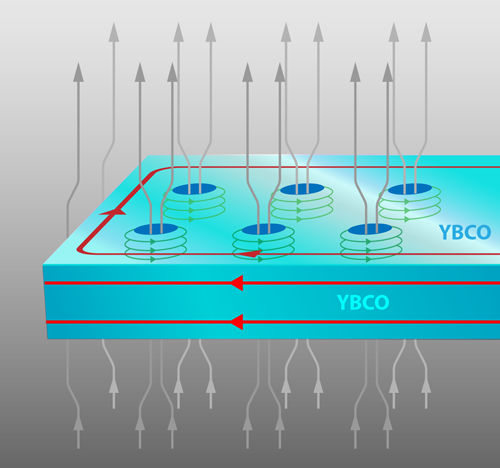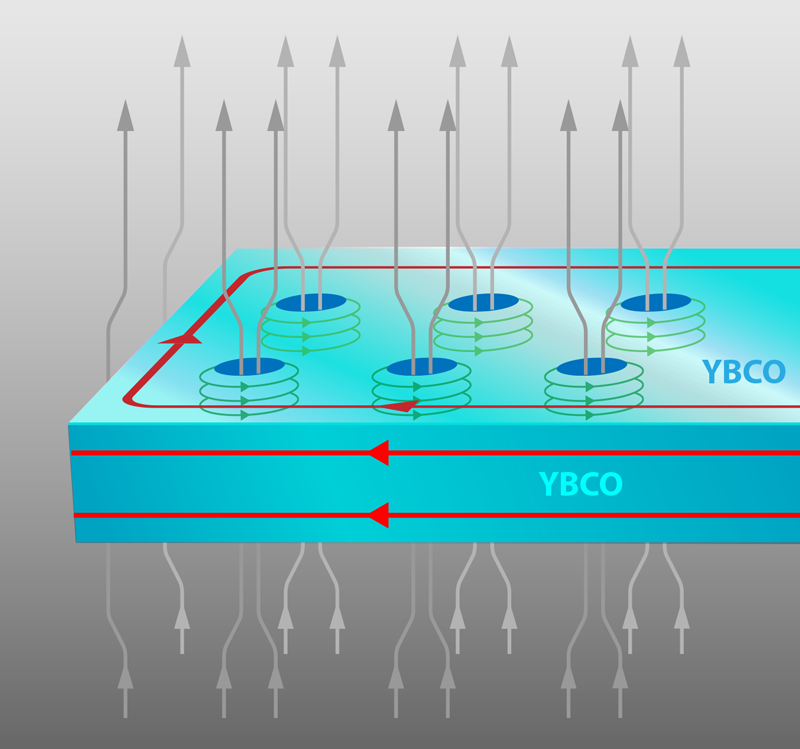Cuprate Superconductors May Be Conventional After All
Copper oxide superconductors, or “cuprates,” are the record holders for the highest critical temperature ( ) at ambient pressure. Among many applications, they might one day be used to make the tens of kilometers of cables that generate accelerating magnetic fields at CERN’s Large Hadron Collider. The origin of high- superconductivity in cuprates, however, remains a major unsolved problem in physics. It is generally believed that the cuprates aren’t adequately described by the theory for ordinary superconductivity, the Bardeen-Cooper-Schrieffer (BCS) theory, since typically these materials do not exhibit features predicted by the theory. Now, a team led by Christoph Renner at the University of Geneva, Switzerland, has demonstrated that a model cuprate hosts vortex states that are a crucial feature of BCS behavior [1]. The finding, they argue, suggests that superconductivity in cuprates is of the conventional type.
Vortex states have been observed in all conventional “type-II” superconductors. Type-II superconductors, which include most of the alloys or ceramics used in MRI scanners and particle accelerators, do not completely repel a magnetic field. The field can penetrate the material through so-called Abrikosov vortices, which are supercurrents of paired electrons (Cooper pairs) that circulate around a nonsuperconducting core (see Fig. 1). In such a vortex, the Cooper pairs act as a potential barrier that confines the nonsuperconducting electrons. According to BCS theory, the lateral confinement results in bound states with discrete energies, known as Caroli–de Gennes–Matricon states [2]. The observation of such vortex-core states in conventional superconductors (for example, in [3]) was a piece of evidence supporting BCS theory. These vortex states can also be helpful in clarifying the mechanism behind superconductivity, because their spatial structure directly reveals the symmetry of the Cooper pairing. Despite intense research efforts, however, these states have not been observed in cuprates. Their absence has been one of the arguments for deeming BCS theory insufficient to describe these materials.
Vortices are typically observed in scanning tunneling spectroscopic measurements, in which a tip scanning over the surface of a superconductor records a peak of conductance as it is placed at a vortex core (the peak is observed when the electrical bias between the tip and the superconductor is zero). In the case of the superconductor studied by Renner and co-workers, (Y123), previous scanning tunneling experiments had revealed certain features (discrete states at energies close to one quarter of the superconductor’s pseudogap) [4] that were initially interpreted as indicators of vortex states. The tunneling spectra—plotting the conductance as a function of electron energy—were, however, inconsistent with BCS predictions. But in 2016, Renner’s group proved that those subgap features were not related to vortices [5].
In their new work, Renner and colleagues set out to find vortex states in Y123. To do so, they had to tackle an experimental hurdle: disentangling superconductivity effects from effects associated with various sorts of collective electronic states, such as charge order, spin order, and pseudogap states, which can coexist with superconductivity in cuprates. These phenomena, just like superconductivity, involve electrons close to the Fermi surface—the fictional surface that, at zero temperature, separates occupied electronic states from empty ones. Hence two different “channels” of electrons, a superconducting (SC) one and a nonsuperconducting (NSC) one, will cooperatively affect the material’s electronic properties and thus the tunneling measurements [6]. Previous work in cuprates revealed that the SC channel has a much lower electron density than the NSC channel [7]. The NSC channel can therefore mask the SC channel, complicating the investigation of vortex states.
To overcome such a challenge, the authors devised a method for removing the NSC contribution to the measured conductance. Key to their approach was the assumption that the SC and NSC channels simply contribute additively to the conductance. After applying a magnetic field and identifying conductance inhomogeneities that could indicate vortices, they subtracted the conductance measured inside the vortices from that measured outside of the vortices. Since the NSC channel is unaffected by the vortices, this approach eliminates the NSC contribution, leaving only the SC one. The SC channel signal derived in this way showed clear zero-bias conductance peaks (ZBCPs) that indicated vortex core states. Scanning a sample surface, the team identified 19 vortex cores. The observed spectroscopic features of the ZBCPs are well described by the BCS theory, leading the authors to interpret them as Caroli–de Gennes–Matricon states inside the vortex cores.
Renner and colleagues’ experiment shows that applying a magnetic field to Y123 produces vortex states similar to those seen in conventional type-II BCS superconductors. While this result doesn’t yet tell us why copper oxides exhibit superconductivity at such high temperatures, it strongly suggests that superconductivity in copper oxides may be of the conventional BCS type. This conclusion is consistent with recent studies, which showed that several types of high- superconductors—including monolayer films ( ) [8] and pressurized ( ) [9]—can also be described by BCS theory. Within this context, the work of Renner’s group may signal that we are getting close to the discovery of a unifying mechanism for high- superconductivity.
Several caveats about this work, however, are worth mentioning. First, the simple hypothesis of an additive tunneling conductance from SC and NSC channels might be questionable: The electrons in the SC channel may interact with those in other channels, complicating the interpretation of the measurements. Further experiments in other materials where the NSC channel has been well characterized will show whether the assumption is justified. Second, the samples may be in a “dirty” regime (in which the mean-free path of electrons is shorter than the coherence length of superconducting Cooper pairs). In such a regime, the vortices do not host bound states, but the subtraction process could lead to signals that could be misinterpreted as the ZBCPs associated with vortex states. Ruling out this possibility would require a quantification of the ZBCP amplitudes. Finally, the vortices measured by the authors exhibit an unexpected variability in their ZBCP spectra: for some vortices the ZBCP splits into a double peak when measured away from the vortex centers, whereas for others it does not. The authors attribute such variability to effects of disorder in the lattice of vortices. Experiments using cleaner samples will be necessary to confirm this interpretation.
While the present work suffers from the above-mentioned limitations, its significance goes beyond the observation of conventional vortex states. The idea of disentangling SC and NSC components may turn out to be a key approach for cracking the mystery of unconventional high- superconductivity. In particular, the results suggest that many low-temperature properties of cuprates, which were previously determined without taking the NSC channel into account, should be revisited. One promising strategy is to investigate directly the copper oxide planes of a cuprate, where the NSC channel is suppressed. This approach was recently followed in Ref. [10], which also revealed features indicating conventional pairing.
This research is published in Physical Review Letters.
References
- “Observation of Caroli–de Gennes–Matricon vortex states in ,” Phys. Rev. Lett. 119, 237001 (2017).
- C. Caroli, P. G. De Gennes, and J. Matricon, “Bound Fermion States on a Vortex Line in a Type II Superconductor,” Phys. Lett. 9, 307 (1964).
- H. F. Hess, R. B. Robinson, R. C. Dynes, J. M. Valles, and J. V. Waszczak, “Scanning-Tunneling-Microscope Observation of the Abrikosov Flux Lattice and the Density of States near and inside a Fluxoid,” Phys. Rev. Lett. 62, 214 (1989).
- Ø. Fischer, M. Kugler, I. Maggio-Aprile, C. Berthod, and C. Renner, “Scanning Tunneling Spectroscopy of High-Temperature Superconductors,” Rev. Mod. Phys. 79, 353 (2007).
- J. Bruér, I. Maggio-Aprile, N. Jenkins, Z. Ristić, A. Erb, C. Berthod, Ø. Fischer, and C. Renner, “Revisiting the Vortex-Core Tunnelling Spectroscopy in ,” Nat. Commun. 7, 11139 (2016).
- S. Hüfner, M. A. Hossain, A. Damascelli, and G. A. Sawatzky, “Two Gaps Make a High-Temperature Superconductor?,” Rep. Prog. Phys. 71, 062501 (2008).
- I. Božović, X. He, J. Wu, and A. T. Bollinger, “Dependence of the Critical Temperature in Overdoped Copper Oxides on Superfluid Density,” Nature 536, 309 (2016).
- Q.-Y. Wang et al., “Interface-Induced High-Temperature Superconductivity in Single Unit-Cell Films on ,” Chin. Phys. Lett. 29, 037402 (2012).
- A. P. Drozdov, M. I. Eremets, I. A. Troyan, V. Ksenofontov, and S. I. Shylin, “Conventional Superconductivity at 203 Kelvin at High Pressures in the Sulfur Hydride System,” Nature 525, 73 (2015).
- Y. Zhong et al., “Nodeless Pairing in Superconducting Copper-Oxide Monolayer Films on ,” Sci. Bull. 61, 1239 (2016).





